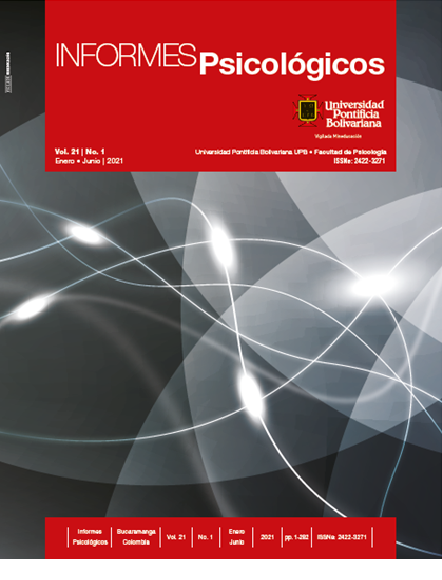Propiedades psicométricas de la Escala de Percepción del Rumor Organizacional (PORS) de 8 ítems en una muestra puertorriqueña
Contenido principal del artículo
Resumen
El estudio tuvo como objetivo evaluar las propiedades psicométricas de la Escala de Percepción del Rumor Organizacional (PORS) de 8 ítems de Vélez-Vega (2019). Contiene dos dimensiones y la escala fue administrada en una muestra puertorriqueña. Un análisis factorial confirmatorio (AFC) probó la validez de constructo utilizando el software AMOS versión 24. La muestra estuvo compuesta por 150 trabajadores adultos, de los cuales el 65% eran mujeres. La escala PORS ha sido validada preliminarmente usando validez de contenido, un análisis factorial exploratorio y un análisis convergente / divergente, pero nunca se sometió a un AFC. Los resultados muestran que la escala final terminó con siete ítems, cumplió con un ajuste de modelo en el Modelo 2 (M2) y tuvo buenos índices CFI, TLI, NFI, RMSEA, AIC y Chi-cuadrado p-value. La escala PORS de 7 ítems tiene un alfa de Cronbach de .86 y el análisis convergente de las dos dimensiones muestra un resultado significativo. La escala mide la validez de constructo y es un instrumento válido para la población puertorriqueña.
Referencias
Aeen, M.N., Zarei, R. & Zarei M.H. (2014). Do the organizational rumors emphasize the influence of organizational silence over organizational commitment? Journal of Social Issues & Humanities, 2(1), 88-93.
Aiken, L.R. & Groth-Marnat, G. (2005). Psychological testing and assessment (12th ed.). New York: Pearson Education.
Bartlett, M.S. (1954). A note of the multiplying factors for various chi square approximations. Journal of the Royal Statistical Society, 16, 296-298.
Bordia, P., Kiazad, K., Restubog, S.L.D., DiFonzo, N., Stenson, N. & Tang, R.L. (2014). Rumor as revenge in the workplace. Group & Organization Management, 39(4), 363-388.
Brown, T. A., (2015). Confirmatory factor analysis for applied research (2nd ed.). New York: The Guilford Press.
Buckner, H.T. (1965). A theory of rumor transmission. Public Opinion Quarterly, 29, 54-70. DOI: 10.1086/267297
Byrne, B. M. (2016). Structural equation modeling with AMOS: Basic concepts, applications, and programming. Structural equation modeling (3rd ed.). New York: Routledge.
Catell, R.B. (1966). The scree test for number of factors. Multivariate Behavioral Research, 1, 245-276.
Creswell, J. W. (2014). Research design qualitative, quantitative, and mixed methods approach (4th ed.). Thousand Oaks, California: SAGE Publications, Inc.
Clegg, S.R., & Van Iterson, A. (2009). Dishing the dirt: Gossiping in organizations. Culture and Organization, 15(3-4), 275-289. http:// dx.doi.org/10.1080/14759550903119293
Dağli, A. & Han, B. (2018). Organizational rumor scale for educational institutions. Universal Journal of Educational Research, 6(5), 936-946.
DeVellis, R.F. (2016). Scale development: Theory and applications (4th ed.). California: Sage.
DiFonzo, N., & Bordia, P. (2013). Rumor psychology: Social and organizational approaches. Washington, D.C: American Psychological Association.
Erden, N.S. (2013). Power distance leads to corporate grapevine: The mediating role of perceptions of uncertainty. Journal of Multidisciplinary Research, 5(1), 95-103.
Fornell, C., & Larker, D.F. (1981). Evaluating structural equation models with unobservable variables and measurement error. Journal of Marketing Research, 18(1), 39-50.
Goodman, M. (1961). Snowball sampling. Annual of Mathematical Statistics, 32(1), 148-170.
Hair, J. F., Black, W. C., Babin, B. J., & Anderson, R. E. (2014). Multivariate data analysis (7th ed.). Harlow, UK: Pearson Education.
Hozouria, M., Yaghmaeib, M., & Bordbara, H. (2018). Clarifying the impacts of organizational silence on organizational commitment with controlling the effects of organizational rumors. Management Science Letters, 8, 533-542.
Kaiser, H. (1970). A second generation Little Jiffy. Psychometrika, 39, 401-415.
Kimmel, A.J. (2012). Rumors and rumor control: A manager's guide to understanding and combating rumors. New York: Routledge.
Kline, T. J. B. (2005). Psychological testing: A practical approach to design and evaluation. Thousand Oaks: SAGE Publications
Rivero, O. (2013). Rumors in the workplace affecting organizational change readiness. Global Journal of Management and Business Research, 13(12), 52-53.
Robbins, S.P. & Judge, T.A. (2018). Organizational behavior (18th ed.). New York, NY: Pearson.
Tabachnick, B. G. & Fidell, L. S. (2013). Using multivariate statistics (6th ed.). Boston, MA: Allyn and Bacon.
Vélez-Vega, A. (2017). A comparison study of organizational rumors and gossip, engagement, and generations in the working sector of Puerto Rico. Revista Interamericana de Psicología Ocupacional, 36(1).
Vélez-Vega, A. (2019). Preliminary construction of the perception of organizational rumor scale (PORS) in a sample of workers in Puerto Rico. Informes Psicológicos, 19(1), 69-84.
Zhang, R. & Li, D. (2019). Identifying influential rumor spreader in social network. Discrete Dynamics in Nature and Society, 2019, 1-10.


